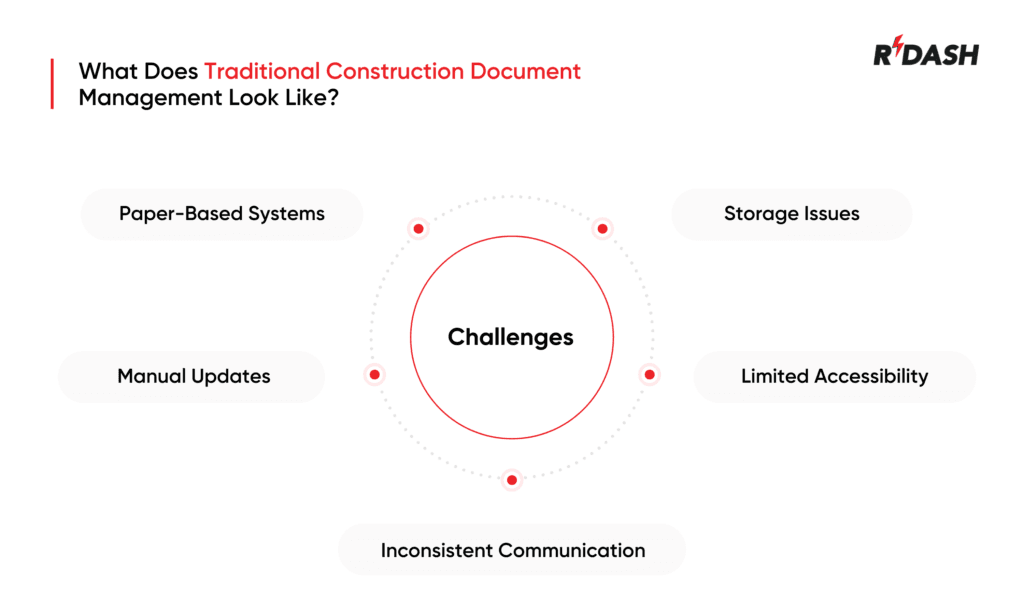What is Construction Document Management?
Construction projects involve many types of documents, such as contracts, blueprints, specifications, reports, and more. Construction document management is the process of organizing, storing, and keeping track of all these important files. It ensures that everyone working on the project can easily access the correct information when needed.
Good document management helps prevent confusion, improves communication among teams, and keeps the project moving smoothly. When a proper system is used, construction teams can stay organized and avoid costly errors.
Common Types of Construction Documents
Construction projects use several types of documents, each with its own purpose. Here are some of the most common types:
- Blueprints and Drawings
These are detailed drawings that show the design and layout of the building, guiding the construction process. - Contracts
Contracts are formal agreements between the project owner and contractors. They define the project’s timeline, costs, duties, and responsibilities. - Specifications
Specifications provide clear instructions about the materials, methods, and quality standards to be used during construction. They play a key role in ensuring consistent quality. - Permits
Permits are official approvals required before construction can begin. They confirm that the project meets local laws and building regulations. - Invoices and Payments
These documents track the financial transactions of the project, including payments for materials, labor, and other services. - Reports and Logs
Daily logs, progress reports, and safety reports help track the project’s status and ensure that safety standards are followed. - Change Orders
These documents outline any changes to the original plans, such as design modifications or schedule adjustments. They help prevent misunderstandings.
Why is Construction Document Management Important?
Construction document management is important for several reasons:

- Organization
With so many documents involved in a project, it’s easy for information to get lost. A proper document management system helps keep everything organized and easily accessible. - Improved Communication
By storing all documents in a central location, everyone—from contractors to the project owner—can access the information they need quickly. This helps improve communication and reduces mistakes. - Efficiency
Having an organized system saves time. When project documents are well organized and easy to access, teams can work faster and avoid delays caused by missing or hard-to-find information. - Reduced Risk of Errors
Construction projects involve many complex tasks and details, increasing the chance of errors if documents are not properly managed. Without proper document management, there’s a higher chance of errors, which can be costly. Keeping track of documents helps ensure that the project stays on course and meets its deadlines. - Legal Protection
Construction projects are full of legal and financial agreements. Properly managing documents like contracts, permits, and change orders helps protect all parties involved in case of disputes. - Compliance with Regulations
Construction projects must comply with local regulations and building codes. Keeping all permits, inspection reports, and compliance documents in order helps ensure the project follows these legal requirements.
Challenges of Construction Document Management
Managing construction documents can be tricky, especially in large-scale projects with hundreds or even thousands of documents to keep track of. Common construction documents include blueprints, contracts, specifications, permits, invoices, and others. Without a proper system, these documents can become disorganized, leading to several challenges.
Here are some of the common challenges in construction document management:
1. Disorganization and Lost Documents
One of the biggest challenges is keeping track of all the documents. In traditional methods, papers can get misplaced, and electronic files can be scattered across different locations. If documents are scattered or disorganized, it can cause confusion and slow down the project when teams need important files quickly.
2. Version Control Issues
Construction projects often involve revisions and updates. Keeping track of the latest versions of documents can become a problem, especially when several team members are working on different versions at the same time. This can result in mistakes or using outdated information.
3. Inefficient Communication
Without a central document storage system, communication between teams can suffer. Different team members might use outdated or conflicting versions of documents, causing confusion, project delays, and mistakes during execution.
4. Compliance Risks
Construction projects must follow strict safety and building regulations. If documents like permits, inspections, and compliance reports aren’t properly managed or stored, it can lead to legal and regulatory issues, which can delay or halt the project.
5. Time-Consuming Manual Processes
In traditional document management systems, teams often spend a lot of time searching for documents, filling out paperwork, and handling approvals manually. This takes time away from actual project work and can lead to unnecessary delays.
6. Lack of Access Control
In some cases, the wrong people may have access to sensitive documents. For example, a contractor may access pricing information that is intended only for project owners, which can lead to security risks and errors in decision-making.
What Does Traditional Construction Document Management Look Like?
In the past, construction document management was mostly paper-based. This meant that contractors, architects, and project managers had to rely on physical copies of documents that were often stored in filing cabinets or dispersed around the job site. This system had many limitations.

1. Paper-Based Systems
In traditional construction document management, all documents were physical copies. These were printed out, signed, and stored in folders or filing cabinets. Every time someone needed a document, they had to search through physical files. This process was slow, prone to mistakes, and inefficient.
2. Manual Updates and Revisions
When documents needed revisions, they were manually updated, printed, and shared. If changes were made late in the project, it was difficult to ensure that everyone was using the latest version. Tracking changes and ensuring that updated versions reached everyone on time was a constant challenge.
3. Limited Accessibility
In a traditional system, documents were only available in certain locations, usually on the job site or at the office. This meant that workers at the site couldn’t always access important documents when needed. This limited accessibility caused delays and sometimes led to mistakes.
4. Inconsistent Communication
In paper-based systems, team members often relied on phone calls, faxes, or in-person meetings to communicate about document changes. This made coordination difficult, especially when teams were working in different locations or time zones. Miscommunication was common, and crucial information could be missed or lost.
5. Storage Issues
Storing and organizing physical documents took up valuable space and was often disorganized. If a document was lost or damaged, it could take a long time to find a copy or make a new one. In larger projects, this became even more problematic as the number of documents increased.
Tips for Improving Your Construction Document Management
Efficient management of construction documents is crucial to keep projects well-organized, on schedule, and within budget limits. Without proper document management, a construction project can quickly become chaotic. Files may get lost, important information may be missed, and communication can break down.
Here are some simple tips to improve how you manage your construction documents:
1. Go Digital
Instead of using paper-based systems, switch to digital document management. Digital files are easier to store, organize, and access. With the right software, you can upload, share, and edit documents from anywhere, which makes it easier for everyone involved to stay on the same page.
2. Use a Centralized System
Keep all your documents in a centralized system where everyone can access them when needed. This ensures that all team members are working with the latest versions and eliminates confusion caused by multiple copies floating around.
3. Create a Clear Filing Structure
A clear filing structure helps organize documents in a way that makes sense for your project. Organize files based on project stages, document categories, or specific trades like electrical or plumbing. This makes it faster to locate needed documents.
4. Implement Version Control
In construction, documents are often updated as the project progresses. Implement version control so that everyone has access to the latest updates and avoids working with outdated documents. When a document is updated, mark it clearly with a version number and the date.
5. Set Access Permissions
Control who can view or edit specific documents. Access permissions ensure that sensitive information is only seen by the right people, which adds a layer of security and prevents mistakes caused by unauthorized changes.
6. Keep a Backup
Always back up your documents. Even with a digital system, there’s a risk of data loss. Make sure to back up files regularly to a secure location (cloud storage or external hard drives) to prevent losing critical information.
Benefits of Upgrading Document Management for Your Construction Business
Upgrading your construction document management system can bring several significant benefits to your business:
1. You Have a Reliable Data Source
With proper document management, you have a reliable data source that you can always turn to for up-to-date information. Having all documents in one place makes it easier to track changes and ensure that everyone is on the same page.
2. Smooth Communication Between Project Members
Upgrading your system improves communication between project members. With digital tools, everyone – from project managers to contractors – can access the same information at any time, making it easier to collaborate and avoid misunderstandings.
3. Construction Accounting Has No Disruptions
Proper document management keeps all financial records—including invoices, payments, and change orders – neatly arranged and easy to find. This makes construction accounting smoother and avoids disruptions caused by missing or disorganized financial data.
4. Tracking daily project progress becomes simpler, allowing teams to make timely adjustments to their plans.
When documents are organized and updated regularly, it’s much easier to track the day-to-day progress of the project. You can quickly see where things stand and make adjustments as needed to keep the project on track.
5. Enhanced Quality Control
With all the right information easily accessible, your team can focus more on quality control. You’ll be able to track materials, inspect work, and ensure that everything meets the required standards, leading to better results and fewer rework costs.
6. Improved Risk Management
Good document management also plays a key role in risk management. By keeping accurate records of contracts, permits, inspections, and safety protocols, you can identify and address risks before they become serious problems, ensuring the project runs smoothly and safely.
RDash offers centralized access to all project documents, ensuring teams work with the most up-to-date information. It simplifies sharing, tracking, and version control, reducing delays and miscommunication. With everything organized in one place, teams can collaborate more efficiently and stay aligned throughout the project.







